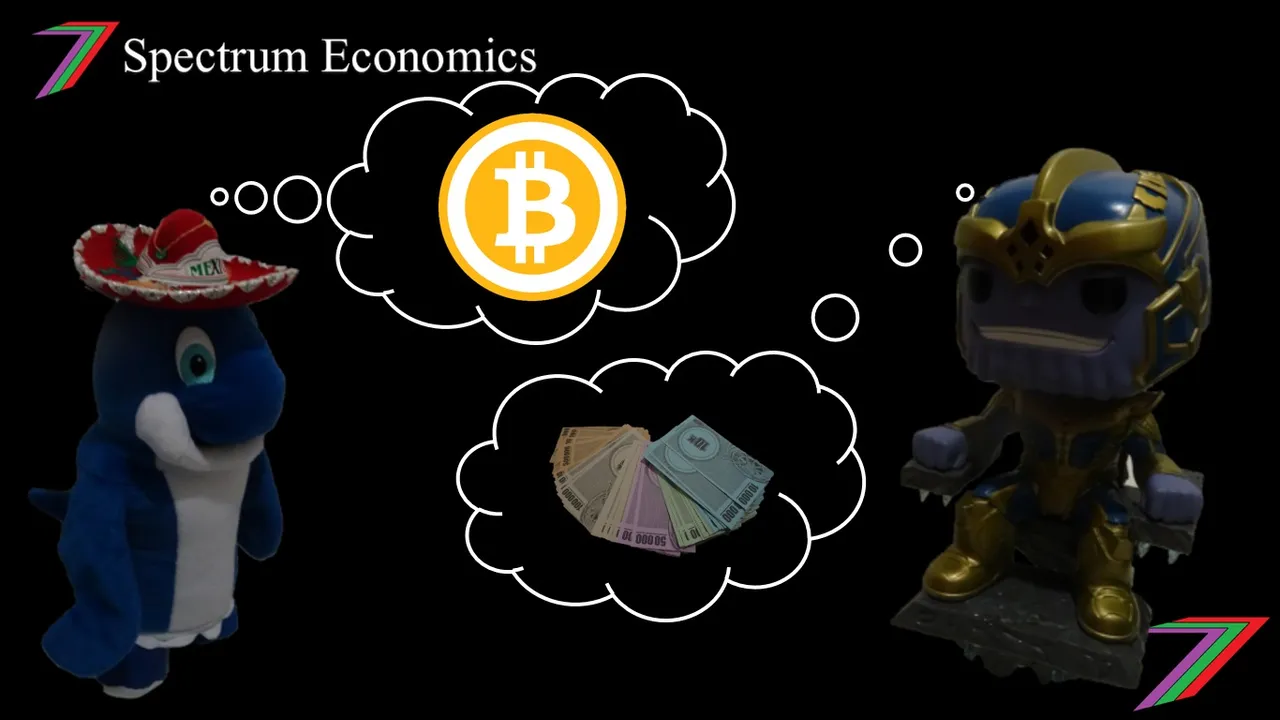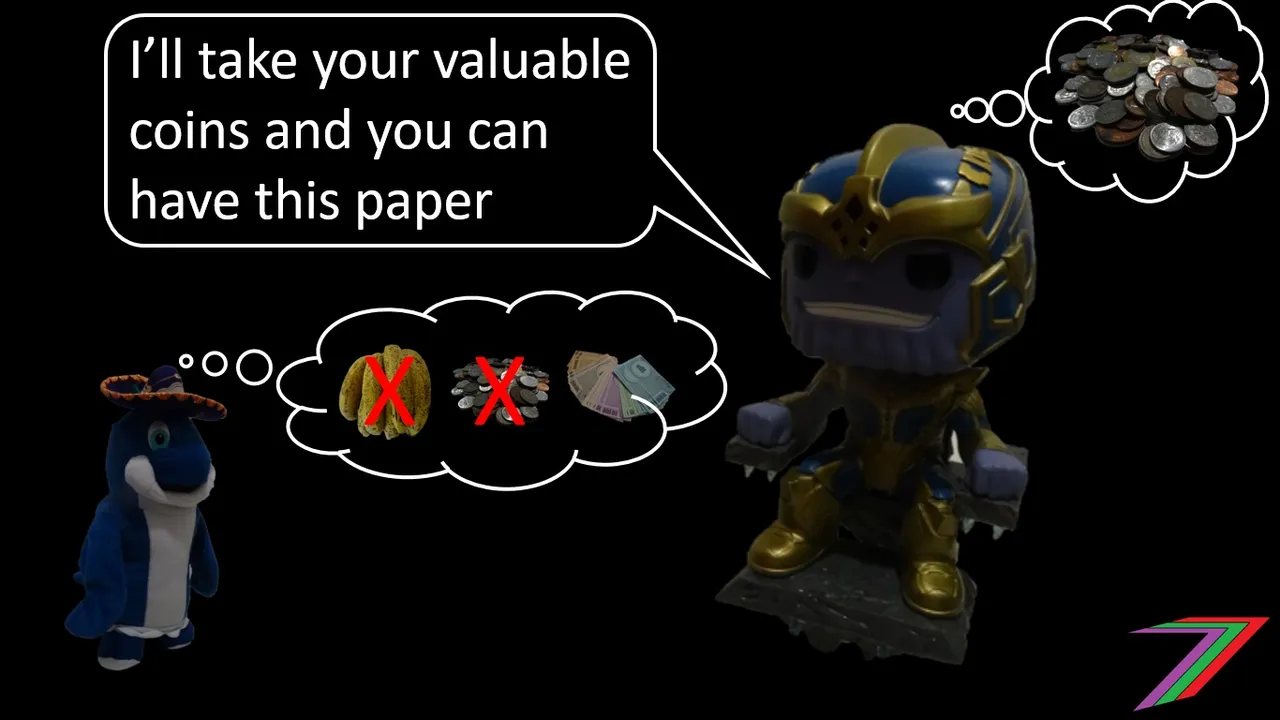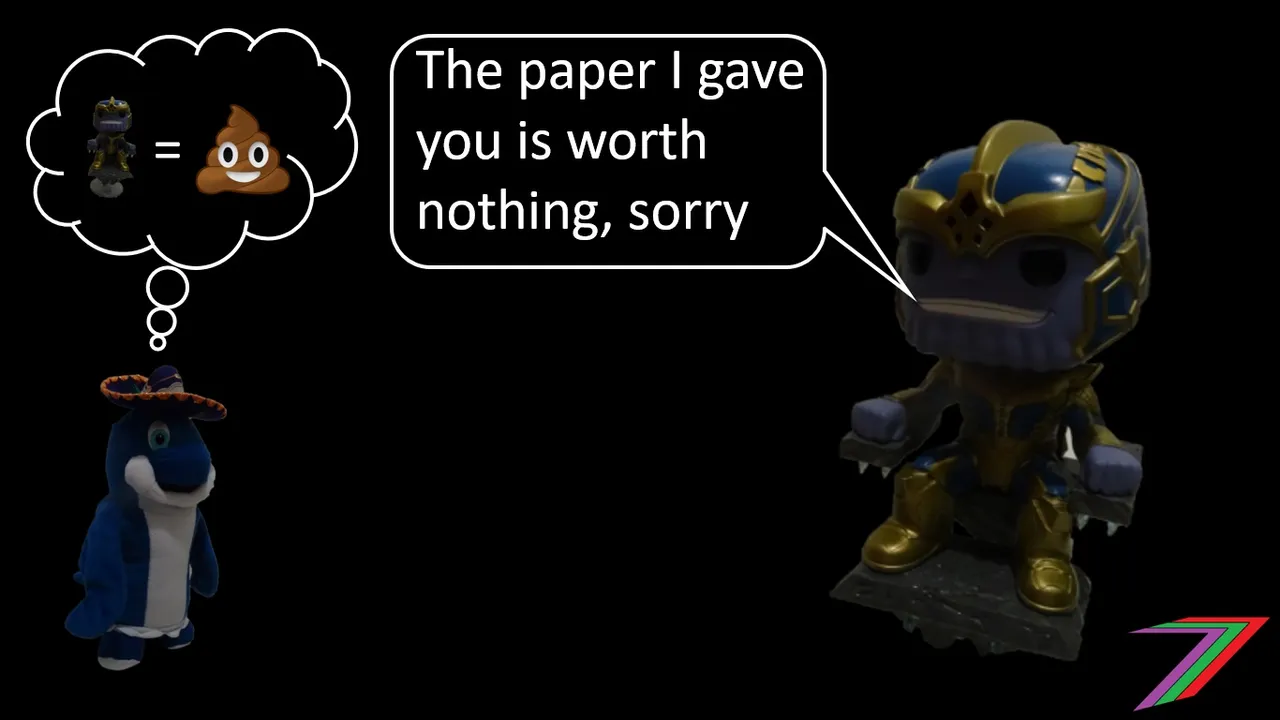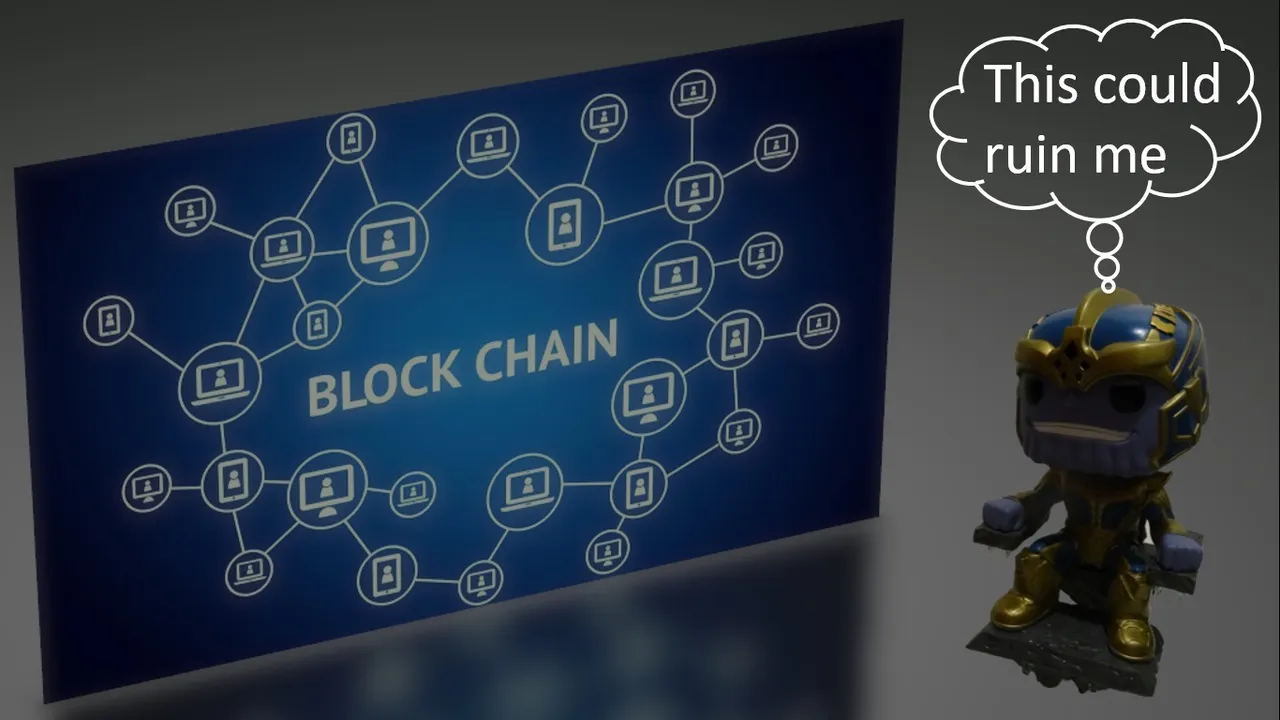Hi Everyone,

In this post, I want to investigate some of the interesting implications of trade. Trade has been essential to the growth of human society. Trade was fundamentally created and exists because we cannot adequately provide for all our own needs and wants by ourselves. We need something from other people.
This post will begin with very basic examples of barter trade amongst a small number of people with limited capacity to produce a wide range of goods and services. The post will progress with larger societies with complex needs, wants and choices. The use of money to increase the effectiveness and efficiency of trade and the problems with determining what can be used as money as well as the desire for authorities to control money are explored.
The post describes replacing money with debt to increase the efficiency of trade as well as provide financial institutions with power and influence over people. The waste of resources to acquire gold that serves only as support for debt is discussed. The post introduces fiat money, which reduces wasteful mining of gold but gives Central Banks incredible control over wealth and the ability to accumulate wealth from nothing (i.e. stealing its citizen’s money by diluting the price of fiat money).
The post concludes by investigating cryptocurrency as an alternative currency to replace the widely used fiat money.
This post is intended to create understanding of the value of trade as well as many of the problems and opportunities that come with it. The post is not a historical account of the evolution of trade and money but highlights the problems that occur as society evolves. The post looks at how particular actors (authority, government etc.) have taken advantage of proposed solutions.
One-person society

Let us start with a one-person society; for example, one person stranded on a desert island. This person has to do everything for himself. If the island does not have everything to sustain this person’s life, he will die. If this person is not able to acquire the necessary survival skills, he will die. If this person becomes sick or injured and if he does not recover quickly, he will die. This person for various reasons is unlikely to have a long fulfilling life.
Small isolated society (basic barter trade)

A one-person society looks bleak for the one person. Let us now assume that there is a small isolated society of a dozen people, for example 12 people shipwrecked on a desert island. These people can choose to live in isolation or live together. They can choose to cooperate to do various tasks to enhance their lives. I would expect these people to cooperate with each other or society will revert to the one-person example. If people work together, tasks can be done more efficiently. There is a wider pool of skill sets. Tasks that require several people can be completed. Others can look after people that become sick or injured. This society can be enhanced if someone is able to invent tools to make tasks easier.
What I have described is the basis for trade. People are doing tasks for each other. One person might dedicated most of his time to building and maintaining shelters. Another person gathers fruits from the jungle. The shelter builder allows the fruit gatherer to stay in the shelter in exchange for fruit. People performing other tasks make similar trades. This is what is referred to as barter trade. The exchange of goods and services for other goods and services.
This small society could be successful if the environment can sufficiently and sustainably provide for the needs and wants for this society. For example, if there is limited access to renewable food, there will be a shortage of food regardless of how well society can cooperate.
Several small societies (growth of barter trade)

A small isolated society has a better chance for survival than a one-person society if people cooperate, work together and trade the products of their work with each other. However, the environment may have limitations that could seal the fate of this society. Let us now assume we have several small societies that are able to access each other. Let us also assume all these societies cooperate to make the most of the skill sets of the people in their society. Different societies will have different strengths and weaknesses. Through interactions between societies, the strengths and weaknesses will become known. People from these societies will focus on their strengths and/or the weaknesses of other societies. In other words, societies will focus on their relative strengths; economists often refer this to ‘comparative advantage’.
Considering the different environments, skill sets, resources, etc. If all societies act civil towards each other, they should thrive. Populations should increase, technology should improve, and variety of goods and services will increase. However, all of the above will hinder trade. For example, someone with coconuts wants shoes and people who have shoes do not want coconuts, how does the person with coconuts obtain shoes. This person may need to make several trades to acquire whatever the person with shoes is willing to accept. Another problem occurs when someone wants to trade large items, which are not easily transportable or divisible. Does trading half a table for 30 apples appear like a sensible method of trading.
As populations grow and the variety of goods and services increases, the problems discussed increase.
A possible solution would be to establish a market where people offer their goods or services and take in exchange whatever they want. This approach could work well for small communities where everyone could hold each other accountable for what they gave and took. On a larger scale and with multiple market places it would become complicated. There is a risk that a central authority would want to control the distribution of goods and services.
Another possible solution is to invent a medium of exchange. Ideally, this medium of exchange should have the following characteristics:
- universally accepted (trade can always occur directly rather than through multiple mediums)
- durable (will not perish or cannot be easily destroyed)
- portable (needs to be small but also contain value)
- uniformity (need to have consistent value)
- possess intrinsic value (has value beyond being used for exchange)
- limited supply (cannot be easily reproduced so that value can be maintained)
- easily divisible (can be divided into smaller denominations so trades can be exact)
In other words, money needed to be invented for trade to be effective and efficient.
Money

So what could be considered as money? Unfortunately, not many things can actually meet the criteria set out. Gold and silver can be considered the closest to meeting the above characteristics. On meeting those characteristics, money was also required to fill three important functions. These functions are as follows:
- medium of exchange
- store of value
- unit of account
These functions can be performed if the seven characteristics are met. The creation of money also required the creation of a service to produce, monitor and issue uniform coins made of gold and silver. Therefore, organisations (i.e. financial intuitions, banks, etc.) are created to provide these services. There is also the problem of introducing money into society. People would not initially recognise or accept the money. Introducing the money is likely to take a long time. The issuing organisation could introduce the money in exchange for services provided or employment. The issuing organisation could also introduce money by trading the money directly for assets. They could force people to adopt the use of money.
Once money (gold and silver) has been successfully introduced, it will greatly increase the ease of trade as goods and services can be exchanged for money, and money can be exchanged for other goods and services. People can obtain what they want without needing to make multiple trades.
As money enhances trade, our societies continue to grow and expand. New societies in areas, which were previously uninhabitable, is possible if that society has access to resources, which are high in demand. For example, a settlement can grow if there is access to oil and almost nothing else, as the oil can be traded for whatever the society needs. Societies that are dependent on trade for most basic needs are also more vulnerable. I will discuss this point in detail in another post.
The existence of money appears to be the solution for creating growth and trade. It also has a few problems. Gold and silver needs to be mined. Mining is not always consistent. New sources of gold and silver need to be discovered to increase the supply. The supply of gold and silver will eventually be exhausted. A limited supply of gold and silver does not necessarily appear to be a bad thing but as gold has an intrinsic value, people can melt the gold coins and use them for other purposes. This will cause the supply of gold currency to deplete. If the circulation of gold and silver is limited, societies might revert back to barter trade.
A possible solution is to issue paper promissory notes instead of money. The money (gold and silver) would be stored at a bank. If someone wanted the value of the promissory note, that person could exchange it with the bank for gold or silver. Therefore, the banks owe people, who hold promissory notes, money
Brief introduction to authority

So far, I have discussed trade in the absence of regulation and authority. To continue this post, I will need to introduce the concept of authority. Authority often takes the form of government and/or leaders of particular groups of people. Authority obtains power through mechanisms such as wealth, religion, culture, force, and consent. The power authority has can be measured by how many people this authority controls as well as the power of the people that the authority controls. People higher up in a hierarchy have more power than those lower down or not part of the hierarchy.
Promissory Notes

Money appeared to be a great solution to increase the ease of trade. Unfortunately, very few things could meet the seven characteristics of money. Gold and silver were considered the best candidates. The limited and unreliable supply as well as people choosing gold and silver for its intrinsic value made it less desirable. A possible solution is to issue and use promissory notes for trading. While gold and silver would be stored out of circulation. The promissory note is not money itself but can be exchanged for money such as gold and silver held by the bank.
For new notes to be issued gold and silver needs to be mined to support the notes, otherwise the notes would be devalued. The notes could be traded directly for gold. Hence, the creation of the gold standard.
The continued mining of gold could be considered a wasteful use of resources as the only purpose the gold serves is to back up the circulating currency. As mentioned earlier, there is a limit on the amount of gold that can be mined. Eventually, the gold standard would need to be replaced by another standard for the continued release of new notes. If there were not a replacement for the gold standard, supply of currency in circulation would not increase. This would result in the relative value of notes to increase and the price of goods and services to fall. The cost of producing goods and services would also naturally fall with improved production techniques and technology. In economics, this is referred to as deflation.
Why is deflation perceived to be bad? Deflation discourages activity and hoarding of money/promissory notes. People and businesses are less like to invest or hire people. Profits and income will fall. This part of the story is bad. However, the inactivity will reduce the supply of goods and services, which will have a positive effect on price. Hence, deflation will be reduced and possibly eliminated; in other words, the problem remedies itself. The net effect will be less output but there is also less demand for that output. Statistically, an economy would look worse off because of reduced output but in reality, the population might be content. This would be the case, if higher demand had been falsely inflated through false expectations.
Fiat Money

Controlling massive quantities of wealth such as gold and silver brings with it the potential for incredible power. Even though, banks do not own all the gold they hold. Some of the gold is owned by the bank acquired for loaning money. Money is often loaned to governments. The physical money remains with bank but the promissory notes are issued to the government. The government then uses the notes to trade. The government is in debt to the banks. They are required to pay interest on this debt.
There is a limit on the amount of money the banks can lend governments as each note produced needs to be backed by gold. To banks and government this a problem, even if it is not for the general population. A solution for the banks and governments is to remove the gold standard. This would allow banks to print as many ‘promissory notes’ as they require and no longer need to acquire gold to do so. However, these are no longer promissory notes, as they no longer can be exchanged for gold by the banks. These notes are referred to as fiat money.
Fiat money gives the banks enormous power. As they can create wealth for themselves by simply printing more fiat money and issuing it as loans. The banks can hold this power for as long as people treat the fiat money as having value and continue to trade with it. The wealth created for the banks does not come from nowhere. The wealth comes from the holders of that particular fiat currency. As more notes are printed the supply of the currency increases. This increases the demand for goods and services in terms of fiat money value. Interest is still paid on the debt to the banks. The banks can loan this interest or convert the interest payments into assets. Therefore banks can acquire assets with real value from the creation of notes that have no value.
It is possible that banks will create new fiat money to the extent that inflation becomes noticeable. This could result in people losing confidence in the fiat money, which results in trading the fiat money for other fiat money or for other assets. If this happens very quickly, the fiat money could lose all of its value. As fiat money has no intrinsic value and there is no guarantee for exchanging it for something that has intrinsic value, the price of a fiat currency could be reduced to zero.
Large external parties can destroy the price of a fiat currency. Demand for a fiat currency could be greatly reduced if trading partners place trade restrictions (e.g. tariffs and embargoes) on societies that use a particular fiat currency. The extent of the impact will depend on the extent of trade with external parties.
Alternative currencies

Banks have had a monopoly on the creation of money and debt. Does this need to be the case? Could private individuals create their own alternative currencies? Seems unlikely, as this currency would be useless if it was not widely accepted. What if this currency could be proven superior to the existing bank issued paper fiat money? For a currency to be superior, it would need to outperform the existing currencies. To do that, we need to revisit, the seven characteristics. The two characteristics that fiat money does not meet are limited supply and intrinsic value. Centralised control over the supply of fiat money is a fundamental cause of this problem. What if the supply was not controlled centrally? Could a decentralised issuing of money solve these problems?
The blockchain

Something known as the blockchain was invented. Different people based on a prescribed methodology continuously update a decentralised ledger. To provide incentive for updating the ledger, a digital currency (cryptocurrency) is issued. The trading price of the currency is dependent on market forces. Decentralised nature of a cryptocurrency prevents the supply from being controlled by one group of people. There are several different methodologies for distributing newly created coins. The most common method is ‘mining’ coins by solving complex equations with computers.
The costs of mining includes the computer hardware as well as the electricity to run the hardware. As the price of the cryptocurrency increases, more people will compete to earn the currency. The increased competition will increase the cost of mining as it becomes more difficult to acquire the coins. The electricity used for mining can be considered wasteful, as it does not contribute to a physical product.
An alternative method of distributing newly created coins is through rewarding people that have contributed something of value. Those that have a stake in the currency determine the distribution of coins. Someone who owns more coins is able to distribute more coins.

The supply of decentralised cryptocurrencies cannot be easily manipulated but do they have intrinsic value? Do the cryptocurrencies have value beyond that of purely a currency? The cryptocurrency might not but the blockchain arguably has intrinsic value. The blockchain stores immutable information that could relate to anything. Could a cryptocurrency meet the seven characteristics and perform the three functions described in this post.
Of the seven characteristics, universal acceptance is any cryptocurrency’s weakness. This is because cryptocurrencies are new. Gold and silver have been recognised as money for thousands of years. Even paper money has been widely used for hundreds of years. Not being universally accepted hinders the currency’s functionality. It will not be a good medium of exchange. It is more susceptible to speculation as it is not widely distributed. This makes it weaker as a unit of account because of price fluctuations. However, as the supply cannot be manipulated and some blockchains have intrinsic value, cryptocurrency’s should be a good store of value in the long-run. If a particular cryptocurrency lacks the potential for eventual increased acceptance, the function as a store of value will diminish.
Conclusion

Trade is essential and will always be essential to the growth of human society. Anything that is essential is likely to be targeted for manipulation. The removal of the gold standard is a perfect example of enabling the easy manipulation of money and wealth into the hands of powerful intuitions.
The arrival of cryptocurrencies provides a great opportunity for people to release themselves from this manipulation. These currencies are new compared to existing fiat currencies and therefore have not achieved mass adoption and circulation. This is gradually changing as more people realise the weaknesses of existing fiat currencies as well as the potential of cryptocurrencies.
This post has focused on the mechanism for the conduct of trade. These included barter trade, money, promissory notes, fiat money, and cryptocurrency. There is a lot more to discuss in the context of trade not covered in this post. I will be writing more posts to discuss other areas of trade as well as other strategies of manipulation. I hope you enjoyed this post.
More posts
If you want to read any of my other posts, you can click on the links below. These links will lead you to posts containing my collection of works. These posts will be updated frequently.




Steem - The Future of DApps




